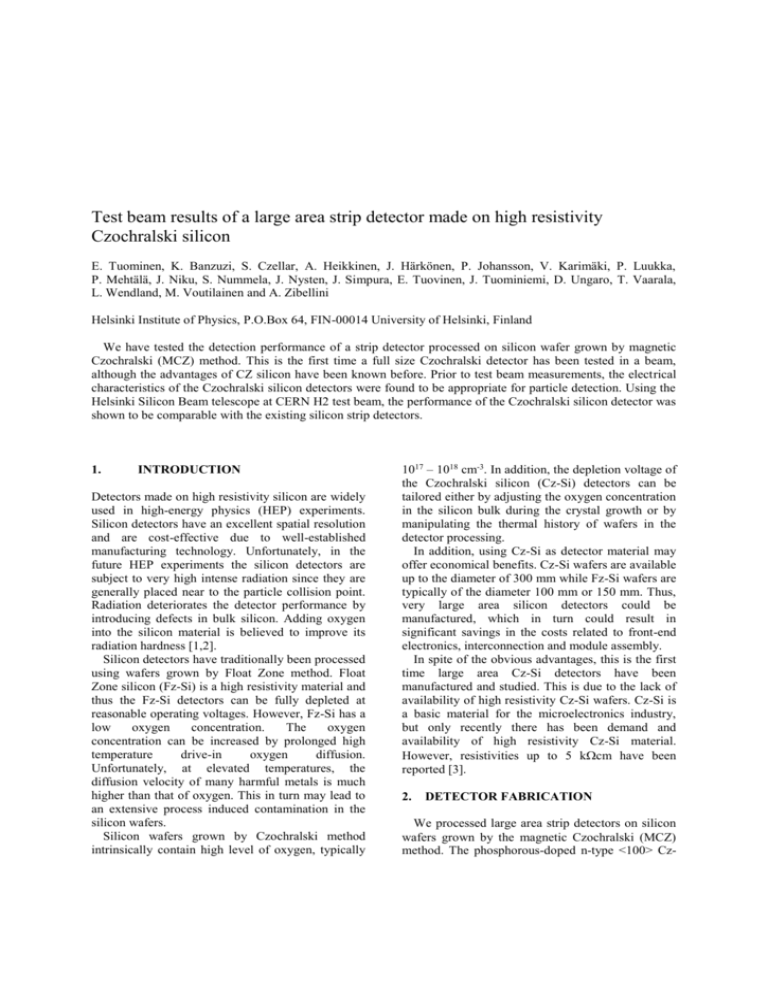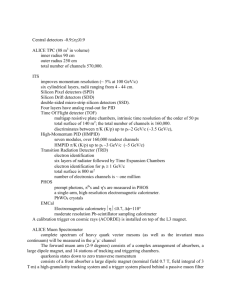Test beam results of a large area strip detector made on high
advertisement

Test beam results of a large area strip detector made on high resistivity Czochralski silicon E. Tuominen, K. Banzuzi, S. Czellar, A. Heikkinen, J. Härkönen, P. Johansson, V. Karimäki, P. Luukka, P. Mehtälä, J. Niku, S. Nummela, J. Nysten, J. Simpura, E. Tuovinen, J. Tuominiemi, D. Ungaro, T. Vaarala, L. Wendland, M. Voutilainen and A. Zibellini Helsinki Institute of Physics, P.O.Box 64, FIN-00014 University of Helsinki, Finland We have tested the detection performance of a strip detector processed on silicon wafer grown by magnetic Czochralski (MCZ) method. This is the first time a full size Czochralski detector has been tested in a beam, although the advantages of CZ silicon have been known before. Prior to test beam measurements, the electrical characteristics of the Czochralski silicon detectors were found to be appropriate for particle detection. Using the Helsinki Silicon Beam telescope at CERN H2 test beam, the performance of the Czochralski silicon detector was shown to be comparable with the existing silicon strip detectors. 1. INTRODUCTION Detectors made on high resistivity silicon are widely used in high-energy physics (HEP) experiments. Silicon detectors have an excellent spatial resolution and are cost-effective due to well-established manufacturing technology. Unfortunately, in the future HEP experiments the silicon detectors are subject to very high intense radiation since they are generally placed near to the particle collision point. Radiation deteriorates the detector performance by introducing defects in bulk silicon. Adding oxygen into the silicon material is believed to improve its radiation hardness [1,2]. Silicon detectors have traditionally been processed using wafers grown by Float Zone method. Float Zone silicon (Fz-Si) is a high resistivity material and thus the Fz-Si detectors can be fully depleted at reasonable operating voltages. However, Fz-Si has a low oxygen concentration. The oxygen concentration can be increased by prolonged high temperature drive-in oxygen diffusion. Unfortunately, at elevated temperatures, the diffusion velocity of many harmful metals is much higher than that of oxygen. This in turn may lead to an extensive process induced contamination in the silicon wafers. Silicon wafers grown by Czochralski method intrinsically contain high level of oxygen, typically 1017 – 1018 cm-3. In addition, the depletion voltage of the Czochralski silicon (Cz-Si) detectors can be tailored either by adjusting the oxygen concentration in the silicon bulk during the crystal growth or by manipulating the thermal history of wafers in the detector processing. In addition, using Cz-Si as detector material may offer economical benefits. Cz-Si wafers are available up to the diameter of 300 mm while Fz-Si wafers are typically of the diameter 100 mm or 150 mm. Thus, very large area silicon detectors could be manufactured, which in turn could result in significant savings in the costs related to front-end electronics, interconnection and module assembly. In spite of the obvious advantages, this is the first time large area Cz-Si detectors have been manufactured and studied. This is due to the lack of availability of high resistivity Cz-Si wafers. Cz-Si is a basic material for the microelectronics industry, but only recently there has been demand and availability of high resistivity Cz-Si material. However, resistivities up to 5 kcm have been reported [3]. 2. DETECTOR FABRICATION We processed large area strip detectors on silicon wafers grown by the magnetic Czochralski (MCZ) method. The phosphorous-doped n-type <100> Cz- 3. ELECTRICAL PROPERTIES OF DETECTORS THE The average lifetime of the minority charge carriers was monitored by the Photoconductivity Decay (PCD) method. The recombination lifetime is a key parameter determining the process quality. The application of the PCD method for detector characterization is described in Ref. [5]. The average lifetime value in the detector area was measured to be about 3000 s, which is adequate for the purposes of particle detection. Leakage current (uA) Current-Voltage (IV) and Capacitance-Voltage (CV) measurements were performed to the completed detectors in order to obtain the values of the reverse bias leakage current and the full depletion voltage, respectively. Fig. 1 shows the leakage current measured from the detector before and after sawing the detector from the wafer. Fig. 2 presents the 1/C2 plot calculated from the capacitance-voltage values measured from a test structure on the same wafer as the detector presented in Fig. 1. 4 3 2 After sawing 1 Before sawing 0 0 100 200 300 400 500 600 700 800 900 Voltage (V) Figure 1. Current–voltage characteristics of the CzSi detector before and after sawing. 8.E-05 1/C^2 / arbitrary units Si wafers manufactured by Okmetic Oyj have a nominal resistivity of about 900 cm. The wafers are single side polished with a thickness of 380 m. The oxygen concentration of the material is less than 10 ppma. This concentration is an order of magnitude larger than is realizable by drive-in diffusion oxygenation, but slightly less than in the Cz-Si wafers typically used in the microelectronics. The relatively low oxygen concentration in the wafers is due to the use of magnetic field, which during the crystal growth is used to control the amount of oxygen dissolving from the silica crucible into the silicon bulk [4]. The low oxygen concentration is favorable in order to avoid unwanted oxygen precipitation during the high temperature treatments during the detector processing. The detectors were processed at the Helsinki University of Technology Microelectronics Center. Our detector fabrication process is very simple containing four lithography levels, two thermal oxidations, two ion implantations, and three sputter depositions. The size of the AC-coupled detector is 32.5 cm2. The width of each of the 1024 p+-strip implants is 10 m, the length is 6,154 cm, and the strip pitch is 50 m. The coupling insulator above each strip is a 200 nm thick silicon dioxide film grown by thermal dry oxidation. Each strip is connected to the common bias line through a bias resistor. Five guard rings surround the active area of the detector. In addition, test structures were processed on the edges of the wafer. For reference purposes, Fz-Si (Topsil AS) detectors were processed simultaneously using single-side-polished 520 m-thick wafers with resistivity of about 3 kcm. The fabrication process is described in detail in Ref. [5]. 6.E-05 4.E-05 2.E-05 0.E+00 0 200 400 600 Voltage(V) 800 1000 Figure 2. 1/C2 plot of the capacitance measurement of a Cz-Si test structure. 4. TEST BEAM MEASUREMENTS After the electrical characterization, the particle detection performance of the Cz-Si detector was studied using the Silicon Beam Telescope (SiBT) of the Helsinki Institute of Physics at the CERN H2 test beam [6, 7]. Strip number ADC channel Figure 3. Hit profile and pulse height distribution (counts per channel) of the Czochralski detector. The telescope is used to measure tracks of incoming particle beams with high-resolution. The SiBT consists of position sensitive silicon detectors attached to readout electronics and a data acquisition system. It offers a reference measurement for research groups testing their detectors at H2. The incoming particle beam passes through four pairs of silicon strip detectors. Every pair consists of one detector with strips positioned horizontally and another with strips positioned vertically. Each detector is glued to a hybrid and bonded to daisychained VA1 readout chips on the same hybrid. Each hybrid is connected to a Front-End-Card, or Repeater Card that delivers the digital control signals sent from the control room to the VA1 chips, and performs additional amplification of the detector signal. The detectors and the Repeater Cards are fixed on top of a granite block using appropriate aluminum support structures. Commercial ADC VME module converts the data into digital form, corrects it for pedestal and common mode, and runs the noise subtraction and cluster finding algorithms. A PC-based Data Acquisition System reads the data through a VMEPCI Interface. The Data Acquisition System is realized with Linux-based C++ code using objectoriented techniques. The off-line analysis of the collected data is performed with an object-oriented software package together with an automatic alignment method. Signal and cluster properties of each detector were studied and plotted. Track reconstruction is performed requiring at least seven hits on a track. The CZ detector proved to perform well as a particle detector. A muon beam of the energy of 225 GeV was used to measure its properties. The important detector parameters, including signal size distributions and signal to noise distributions, were successfully extracted from the CZ detector. The efficiency of the detector was measured to be 95 %, the resolution about 10 um, and the signal to noise ratio about 10. Hit profile and pulse height distribution of the Czochralski detector is shown in Fig. 3. The graph includes 1E6 muon events. 5. CONCLUSIONS We have tested the detection performance of a strip detector processed on silicon wafer grown by the magnetic Czochralski (MCZ) method. Silicon wafers grown with Czochralski method intrinsically contain high level of oxygen, and thus have potential for radiation hardness. This is the first time large area Czochralski silicon detectors have been manufactured, tested electrically, and tested in a particle beam. Our electrical measurements showed that the CzSi detector can be depleted with reasonable operating voltages, i.e. 420 V for a 380 m thick detector. In addition, the leakage current is relatively low at full depletion, about 2.4 A from the detector area of 32.5 cm2. Furthermore, the detectors could be biased up to 1000 V without breakdown. The resistivity of the processed detectors was about 1200 cm. The CZ detector proved to perform well as a particle detector. Important detector parameters, including signal size distributions and signal to noise distributions, were successfully extracted from the CZ detector. The resolution of the Czochralski Silicon detector was found to be 10 m, efficiency 95 %, and the signal to noise ratio about 10. ACKNOWLEDGMENTS The authors are most grateful for Mr. Ian McGill and Dr. Christian Joram from CERN’s SSD group for their very kind help in wire bonding. Additionally, we thank Mr. Jaakko Salonen from VTT Information Technology for his support and assistance in optical lithography. REFERENCES 1. 2. 3. 4. 5. 6. 7. Z. Li & al., IEEE Trans. Nucl. Sci. 39 (6) (1992) 1730 – 1738. G. Lindström & al., Nucl. Instr. and Meth., A466 (2) (2001), 308-326. T. Abe and W. Qu, , Electrochemical Society Proc. Vol. 2000-17 (2000) 491-500. V. Savolainen et al., Journal of Crystal Growth, Article in Press. J. Härkönen et al., Nucl. Instr. and Meth., A485 (2002) 159-165. C. Eklund et al., Nucl. Instr. and Meth. A430 (1999) 321-332. K. Banzuzi et al., Nucl. Instr. and Meth. A453 (2000) 536-544.




